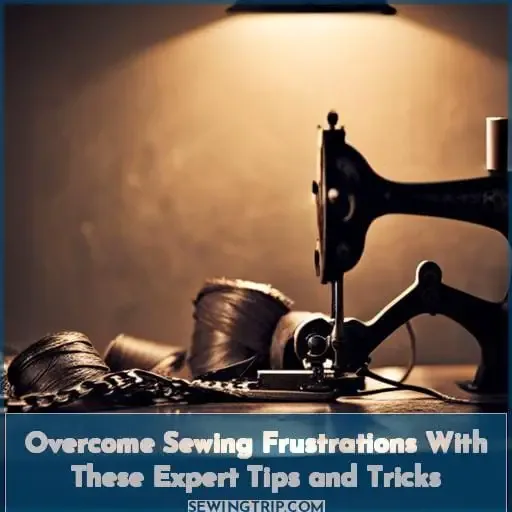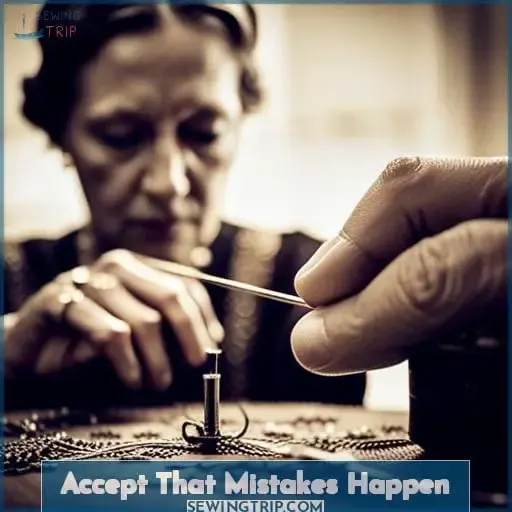This site is supported by our readers. We may earn a commission, at no cost to you, if you purchase through links.
 You’re itching to start that new sewing project, but your last attempt left you tangled in a knot of tangled threads and pricked fingers. Don’t let frustration unravel your passion for creating handmade magic! With a few tips up your sleeve, you can stitch success and develop the confidence to cut through tricky techniques.
You’re itching to start that new sewing project, but your last attempt left you tangled in a knot of tangled threads and pricked fingers. Don’t let frustration unravel your passion for creating handmade magic! With a few tips up your sleeve, you can stitch success and develop the confidence to cut through tricky techniques.
First, choose fabric and patterns within your skill set – intricate embroidery on slippery satin will fray your nerves. Start simple, like a basic A-line skirt; you can always jazz it up with trims once you’ve nailed the basics.
And don’t forget the value of mistakes; they’re your guide, revealing what needs more practice.
With patience and persistence, you’ll be whipping up showstoppers in no time. So thread your machine, take a deep breath, and let your creativity sew.
Table Of Contents
Key Takeaways
- Sewing can be frustrating due to the need for patience and perseverance in mastering techniques.
- Mistakes and setbacks should be viewed as opportunities for growth and learning.
- Connecting with the sewing community can provide support, knowledge, and inspiration.
- Embracing challenges and setbacks in sewing will ultimately lead to a rewarding and fulfilling journey.
Accept That Mistakes Happen
You know sewing can be frustrating, but stay positive! Choose appropriate projects, practice first, and set realistic goals. With a ‘can-do’ attitude, you’ll master new techniques and complete amazing projects.
Adopt a ‘can Do’ Attitude
You’d be wise to believe in yourself and your abilities. When sewing gets frustrating:
- Lean into challenges.
- Adapt to setbacks.
- Connect with the community.
- Reassess goals.
Trust the process. Mistakes are opportunities to learn. Choose projects suitable for your skill level and set realistic goals.
Choose Appropriate Projects
Instead of diving into the deep end, wade into sewing’s waters gradually through simple projects that let you get your feet wet before going for an Olympic medal in sewing.
| Project | Skill Level | Time Commitment |
|---|---|---|
| Pillowcases | Beginner | 2 hours |
| Tote Bags | Beginner | 3 hours |
| Skirts | Intermediate | 8 hours |
| Dresses | Advanced | 16+ hours |
As you build your skills through starter projects, you’ll gain confidence to tackle more complex endeavors. Celebrate small successes, and mistakes become opportunities to learn. With patience and persistence, you’ll find flow in sewing’s rhythms and embrace the creative journey.
Practice and Experiment First
Why not start small and play with scraps first? Cut up those old t-shirts and tablecloths to test different techniques. Try various needles and threads on tiny swatches before picking quality fabric for a big project.
Watch tutorial videos to learn proper cutting. With a scrap-first approach, you gain skills and confidence to tackle any pattern.
Set Realistic Goals
Getting overly ambitious with a complex sewing project as a beginner will likely result in frustration. For example, attempting an intricate formal gown without having mastered basic construction techniques may lead to fraying seams, puckered fabric, and general irritation.
Instead, practice patience by starting with simple projects to build skills. Research fitting techniques online and budget extra fabric to allow creative freedom.
Frequently Asked Questions (FAQs)
How can I stay motivated when a project feels overwhelming?
Stay focused on your vision. Break it down into small, achievable steps. Celebrate every little victory.
What are some common fitting issues and how can I adjust patterns to fit my body type?
Take accurate measurements and compare them to pattern sizes. Make a muslin to test. Pin fit the muslin, marking any necessary changes. Transfer the adjustments to the paper pattern. Let out or take in seams as needed. Lower or raise the waistline. Add darts if necessary.
What sewing tools or gadgets can help make tricky techniques like buttonholes easier?
You think a fancy new gadget will make buttonholes easier? My friend, the only tool you need is patience. Master basic techniques first, and then the tricks come naturally. Relax, breathe deeply, and sew on.
Where can I find a local sewing community or sewing circle to connect with other sewers?
You’ll find your tribe at the local fabric store‘s classes or meetups. Bonding over projects builds community.
Are there any online or in-person sewing classes you’d recommend for beginners?
Keep trying! Learn from YouTube tutorials. Find local sewing classes through parks departments, fabric stores, or community colleges.
Conclusion
We all have frustrating moments while sewing; it’s part of the creative process. When you hit those inevitable snags, take a breath and remember it’s about the journey, not perfection.
Don’t be afraid of mistakes; they’re how we learn and grow. Keep trying new techniques, embrace the challenges, and appreciate how each project makes you a better, more confident sewer.
While sewing can sometimes be frustrating, the end result of creating something beautiful is so rewarding. So keep pushing forward and know that all your effort will be worth it when you can wear or gift your finished project with pride.







